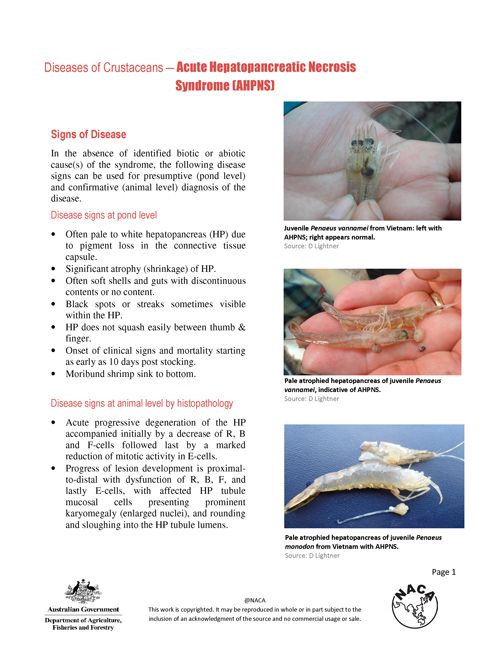Acute hepatopancreatic necrosis disease card
18 September 2012 | 1760 Downloads | .pdf | 2.24 MB | Health and Biosecurity, Shrimp
In the absence of identified biotic or abiotic cause(s) of the syndrome, this disease card provides information on signs that can be used for presumptive (pond level) and confirmative (animal level) diagnosis of acute hepatopancreatic necrosis syndrome (AHPNS) of shrimp.
Heavy mortalities during the early stages of a shrimp crop are not unusual and there are a variety of management and pathogen related factors that can cause such losses, which are often described by the catch-all term "early mortality syndrome". However, in 2010 a new and distinctive pattern of mortalities began to be noticed, affecting both Penaeus vannamei and P. monodon.
The syndrome involves mass mortalities of up to 100% during the first 20-30 days after stocking. Affected shrimp consistently show an abnormal hepatopancreas, which may be shrunken, swollen or discoloured; loose shells, corkscrew swimming, pale colouration and slow growth. Given that these symptoms appear to be distinctive, the name "acute hepatopancreatic necrosis syndrome" has been proposed as a more appropriate term, to distinguish this condition from other causes of early mortalities.
The syndrome was first reported from China and Vietnam in 2010, Malaysia in 2011. In 2012 it has also been reported in Thailand. The syndrome has caused severe economic losses throughout the region. The cause is not yet known.
This disease card was developed as a result of the Emergency Regional Consultation on Acute Hepatopancreatic Necrosis Syndrome, held in Bangkok, 9-10 August 2012. Audio recordings of the presentations made at the consultation are available for download or streaming.
Creative Commons Attribution.

